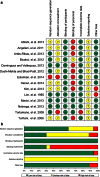The effectiveness of low-level diode laser therapy on orthodontic pain management: a systematic review and meta-analysis
- PMID: 25800534
- PMCID: PMC4562996
- DOI: 10.1007/s10103-015-1743-4
The effectiveness of low-level diode laser therapy on orthodontic pain management: a systematic review and meta-analysis
Abstract
To assess the effectiveness of diode low-level laser therapy (LLLT) for orthodontic pain control, a systematic and extensive electronic search for randomised controlled trials (RCTs) investigating the effects of diode LLLT on orthodontic pain prior to November 2014 was performed using the Cochrane Library (Issue 9, 2014), PubMed (1997), EMBASE (1947) and Web of Science (1956). The Cochrane tool for risk of bias evaluation was used to assess the bias risk in the chosen data. A meta-analysis was conducted using RevMan 5.3. Of the 186 results, 14 RCTs, with a total of 659 participants from 11 countries, were included. Except for three studies assessed as having a 'moderate risk of bias', the RCTs were rated as having a 'high risk of bias'. The methodological weaknesses were mainly due to 'blinding' and 'allocation concealment'. The meta-analysis showed that diode LLLT significantly reduced orthodontic pain by 39 % in comparison with placebo groups (P = 0.02). Diode LLLT was shown to significantly reduce the maximum pain intensity among parallel-design studies (P = 0.003 versus placebo groups; P = 0.000 versus control groups). However, no significant effects were shown for split-mouth-design studies (P = 0.38 versus placebo groups). It was concluded that the use of diode LLLT for orthodontic pain appears promising. However, due to methodological weaknesses, there was insufficient evidence to support or refute LLLT's effectiveness. RCTs with better designs and appropriate sample power are required to provide stronger evidence for diode LLLT's clinical applications.
Figures





References
-
- Polat Ö. Pain and discomfort after orthodontic appointments. Semin Orthod. 2007;13(4):292–300. doi: 10.1053/j.sodo.2007.08.010. - DOI
Publication types
MeSH terms
LinkOut - more resources
Full Text Sources
Other Literature Sources
Medical

